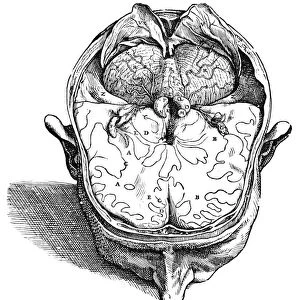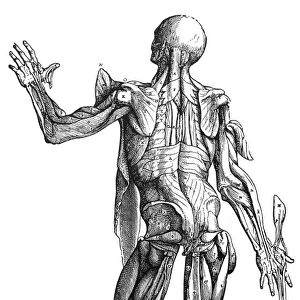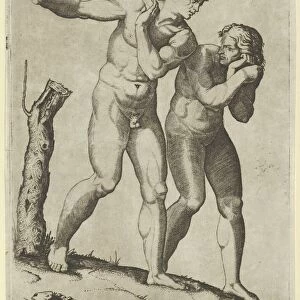Metal Print > Granger Art on Demand > Medicine
Metal Print : Dissection of the brain (fig. 5). Woodcut from the seventh book of Andreas Vesalius De Humani Corporis Fabrica, published in 1543 at Basel, Switzerland
![]()

Metal Prints from Granger
Dissection of the brain (fig. 5). Woodcut from the seventh book of Andreas Vesalius De Humani Corporis Fabrica, published in 1543 at Basel, Switzerland
VESALIUS: BRAIN, 1543.
Dissection of the brain (fig.5). Woodcut from the seventh book of Andreas Vesalius De Humani Corporis Fabrica, published in 1543 at Basel, Switzerland
Granger holds millions of images spanning more than 25,000 years of world history, from before the Stone Age to the dawn of the Space Age
Media ID 10411292
1543 Anatomy Andrea Andreas Belgian Biology Brain De Humani Corporis Fabrica Diagram Dissection Medicine Organ Scientific Revolution Vesalius
16"x20" (51x41cm) Metal Print
Experience the intricacy and complexity of the human brain with our Media Storehouse Metal Prints. This captivating image is taken from the seventh book of Andreas Vesalius' De Humani Corporis Fabrica, published in 1543. The woodcut, titled "Dissection of the brain (fig.5)", showcases the meticulous detail of the human brain as it was first discovered and documented by Vesalius. Bring this historical masterpiece into your home or office and ignite conversations with its intriguing and thought-provoking design. Order your Metal Print today and elevate your space with a piece of scientific history.
Made with durable metal and luxurious printing techniques, our metal photo prints go beyond traditional canvases, adding a cool, modern touch to your space. Wall mount on back. Eco-friendly 100% post-consumer recycled ChromaLuxe aluminum surface. The thickness of the print is 0.045". Featuring a Scratch-resistant surface and Rounded corners. Backing hangers are attached to the back of the print and float the print 1/2-inch off the wall when hung, the choice of hanger may vary depending on size and International orders will come with Float Mount hangers only. Finished with a brilliant white high gloss surface for unsurpassed detail and vibrance. Printed using Dye-Sublimation and for best care we recommend a non-ammonia glass cleaner, water, or isopropyl (rubbing) alcohol to prevent harming the print surface. We recommend using a clean, lint-free cloth to wipe off the print. The ultra-hard surface is scratch-resistant, waterproof and weatherproof. Avoid direct sunlight exposure.
Made with durable metal and luxurious printing techniques, metal prints bring images to life and add a modern touch to any space
Estimated Image Size (if not cropped) is 40.6cm x 50.8cm (16" x 20")
Estimated Product Size is 41.2cm x 51.4cm (16.2" x 20.2")
These are individually made so all sizes are approximate
Artwork printed orientated as per the preview above, with portrait (vertical) orientation to match the source image.
FEATURES IN THESE COLLECTIONS
> Granger Art on Demand
> Medicine
> Granger Art on Demand
> Plans and Diagrams
EDITORS COMMENTS
This print showcases a woodcut from the seventh book of Andreas Vesalius' groundbreaking work, De Humani Corporis Fabrica, published in 1543 at Basel, Switzerland. The woodcut specifically depicts the dissection of the brain (fig. 5), offering a remarkable glimpse into the world of anatomy during the Renaissance period. Andreas Vesalius, a Belgian anatomist and physician, revolutionized medical understanding with his meticulous observations and detailed illustrations. This particular woodcut exemplifies his commitment to scientific accuracy and artistic finesse. It serves as an invaluable resource for both biology and medicine enthusiasts alike. The intricate diagram captures the complexity of this vital organ while showcasing Vesalius' mastery in capturing anatomical details through woodblock printing techniques. As we explore this image further, we are transported back to a time when dissections were rare and highly controversial acts that challenged societal norms. Beyond its historical significance, this print also symbolizes humanity's relentless pursuit of knowledge during the Scientific Revolution. It stands as a testament to our innate curiosity about ourselves and our bodies. Whether you are fascinated by anatomy or simply appreciate artistry combined with scientific inquiry, this print offers an exquisite visual representation that will undoubtedly captivate your imagination.
MADE IN THE USA
Safe Shipping with 30 Day Money Back Guarantee
FREE PERSONALISATION*
We are proud to offer a range of customisation features including Personalised Captions, Color Filters and Picture Zoom Tools
SECURE PAYMENTS
We happily accept a wide range of payment options so you can pay for the things you need in the way that is most convenient for you
* Options may vary by product and licensing agreement. Zoomed Pictures can be adjusted in the Cart.






